
4-Hydroxy-N,N-diisopropyltryptamine is a synthetic psychedelic drug. It is a higher homologue of psilocin, 4-HO-DET, and is a positional isomer of 4-HO-DPT and has a tryptamine molecular sub-structure.

2C-T-4 (2,5-dimethoxy-4-isopropylthiophenethylamine) is a psychedelic phenethylamine of the 2C family. It was first synthesized by Alexander Shulgin and is used as entheogenic recreational drug.

5-MeO-DPT, is a psychedelic and entheogenic designer drug.

2C-T is a psychedelic and hallucinogenic drug of the 2C family. It is used by some as an entheogen. It has structural and pharmacodynamic properties similar to the drugs mescaline and 2C-T-2.

EiPT is a chemical in the tryptamine family, and produces psychedelic and hallucinogenic effects. It was probably first synthesized by Alexander Shulgin.
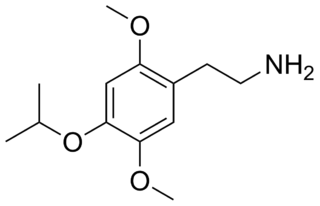
2C-O-4 (4-isopropoxy-2,5-dimethoxyphenethylamine) is a phenethylamine of the 2C family. It is also a positional isomer of isoproscaline and was probably first synthesized by Alexander Shulgin. It produces hallucinogenic, psychedelic, and entheogenic effects. Because of the low potency of 2C-O-4, and the inactivity of 2C-O, Shulgin felt that the 2C-O series would not be an exciting area for research, and did not pursue any further analogues.
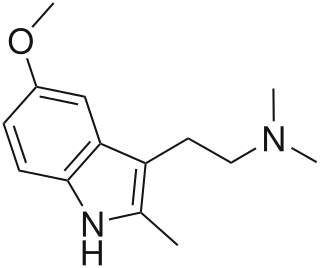
5-Methoxy-2,N,N-trimethyltryptamine is a psychoactive drug of the tryptamine chemical class which acts as a psychedelic. It was first synthesized by Alexander Shulgin and reported in his book TiHKAL. 5-MeO-TMT is claimed to show psychoactive effects at a dosage of 75–150 mg orally, but these are relatively mild compared to those of other similar compounds. This suggests that while the methyl group on the 2-position of the molecule has impaired the binding of metabolic enzymes like monoamine oxidase (MAO), it is also interfering with binding to and/or activation of the serotonin 5-HT2A receptor, the target responsible for mediating the hallucinogenic effects of such compounds.

2C-T-17 or 2,5-dimethoxy-4-(β-secbutylthio)phenethylamine is a psychedelic phenethylamine of the 2C family. It was presumably first synthesized by Alexander Shulgin and reported in his book PiHKAL .
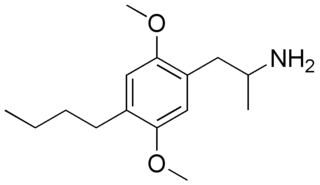
2,5-Dimethoxy-4-butylamphetamine (DOBU) is a lesser-known psychedelic drug and a substituted Amphetamine. DOBU was first synthesized by Alexander Shulgin. In his book PiHKAL (Phenethylamines i Have Known And Loved), only low dosages of 2–3 mg were tested, with the duration simply listed as "very long". DOBU produces paresthesia and difficulty sleeping, but with few other effects. Compared to shorter chain homologues such as DOM, DOET and DOPR which are all potent hallucinogens, DOBU has an even stronger 5-HT2 binding affinity but fails to substitute for hallucinogens in animals or produce hallucinogenic effects in humans, suggesting it has low efficacy and is thus an antagonist or weak partial agonist at the 5-HT2A receptor.
Dimethoxyamphetamine (DMA) is a series of six lesser-known psychedelic drugs similar in structure to the three isomers of methoxyamphetamine and six isomers of trimethoxyamphetamine. The isomers are 2,3-DMA, 2,4-DMA, 2,5-DMA, 2,6-DMA, 3,4-DMA, and 3,5-DMA. Three of the isomers were characterized by Alexander Shulgin in his book PiHKAL. Little is known about their dangers or toxicity.
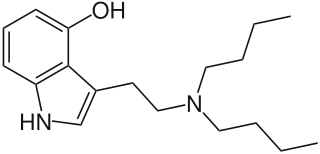
4-Hydroxy-N,N-dibutyltryptamine (4-HO-DBT) is a psychedelic drug belonging to the tryptamine family. It is found either as its crystalline hydrochloride salt or as an oily or crystalline base. 4-HO-DBT was first made by the chemist Alexander Shulgin and reported in his book TiHKAL. Shulgin reported a dosage of 20 mg orally to be without effects. However this compound has subsequently been sold as a "research chemical" and anecdotal reports suggest that at higher doses 4-HO-DBT is indeed an active hallucinogen, although somewhat weaker than other similar tryptamine derivatives.

MBT, or N-methyl-N-butyltryptamine, is a lesser-known psychedelic drug. MBT was first synthesized by Alexander Shulgin. In his book TiHKAL, the minimum dosage is listed as 250-400 mg, and the duration listed as 4–6 hours. MBT produces a heavy body load with dehydration, and causes visuals similar to those of DMT. Very little data exists about the pharmacological properties, metabolism, and toxicity of MBT.

4-HO-MET, is a lesser-known psychedelic drug. It is a structural− and functional analog of psilocin as well as the 4-hydroxyl analog of methylethyltryptamine (MET). 4-HO-MET was first synthesized by Alexander Shulgin. In his book TiHKAL, the dosage is listed as 10-20 mg. 4-HO-MET produces psilocin-like distortion of color, sound, and form. Very little data exists about the pharmacological properties, metabolism, and toxicity of 4-HO-MET. There have been no reports of deaths from 4-HO-MET, even though people have reported taking doses up to 150 mg, more than an order of magnitude above the effective dose.

4-Hydroxy-N-methyl-N-propyltryptamine, commonly known as 4-HO-MPT or meprocin, is a psychedelic drug in the tryptamine class of chemical compounds and is a higher homologue of the naturally occurring substituted tryptamine psilocin as well as being the 4-hydroxyl analog of MPT.
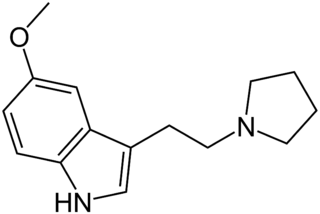
5-MeO-pyr-T (5-methoxy-N,N-tetramethylenetryptamine) is a lesser-known psychedelic drug. It is the 5-methoxy analog of pyr-T. 5-MeO-pyr-T was first synthesized by Hunt & Brimblecombe, who credited S. Mitzal for characterization of chemical properties. Later human tests were reported by Alexander Shulgin, in his book TiHKAL. An oral dosage of 0.5 to 2 mg, and an inhaled dosage of 2–3 mg are reported. 5-MeO-pyr-T causes varying reactions, such as amnesia, tinnitus, vomiting, and a 5-MeO-DMT-like rushing sensation. At the highest dosage reported in TiHKAL, the subject describes awakening from an apparent fugue state during which they were wandering the streets, with complete amnesia upon awakening.
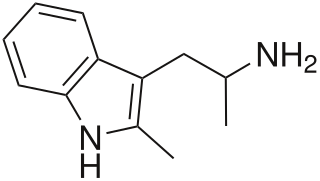
2,alpha-DMT, or 2,α-dimethyltryptamine, is a tryptamine and a lesser-known psychedelic drug. It is the 2,a-dimethyl analog of DMT. 2,α-DMT was first synthesized by Alexander Shulgin. In his book TiHKAL, Shulgin lists the dosage as 300-500 mg, and the duration as 7–10 hours. 2,α-DMT causes mydriasis and paresthesia. It also produces a calm, drunk-like feeling. Very little data exists about the pharmacological properties, metabolism, and toxicity of 2,α-DMT.

Alpha,N-DMT, or α,N-dimethyltryptamine, is a lesser-known psychedelic drug. It is the α,N-dimethyl analog of DMT. α,N-DMT was first synthesized by Alexander Shulgin. In his book TiHKAL, Shulgin lists the dosage as 50-100 mg, and the duration as 6–8 hours. α,N-DMT causes an unpleasant body load. Very little data exists about the pharmacological properties, metabolism, and toxicity of α,N-DMT.
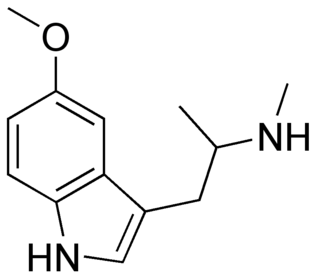
Alpha,N,O-TMS, or α,N-dimethyl-5-methoxytryptamine, is a lesser-known psychedelic drug. Its abbreviated nomenclature is derived from its structure, as it is α,N,O-trimethyl serotonin. α,N,O-TMS was first synthesized by Alexander Shulgin. In his book TiHKAL, Shulgin lists the dosage as 10-20 mg when taken orally, and the duration as 6–8 hours.

4-HO-DsBT (4-hydroxy-N,N-di-sec-butyltryptamine) is a tryptamine derivative which acts as a serotonin receptor agonist. It was first made by Alexander Shulgin and is mentioned in his book TiHKAL, but was never tested by him. However it has subsequently been tested in vitro and unlike the n-butyl and isobutyl isomers which are much weaker, the s-butyl derivative retains reasonable potency, with a similar 5-HT2A receptor affinity to MiPT but better selectivity over the 5-HT1A and 5-HT2B subtypes.

N-t-Butyltryptamine (NTBT) is a tryptamine derivative which has serotonergic effects. It is described by Alexander Shulgin as producing "a light-headed intoxication that is a totally pleasant buzz, but nothing more profound than that" at a dosage range of 5 to 20 mg, along with the related sec-butyl isomer NSBT which is similar in effects but slightly less potent.




















